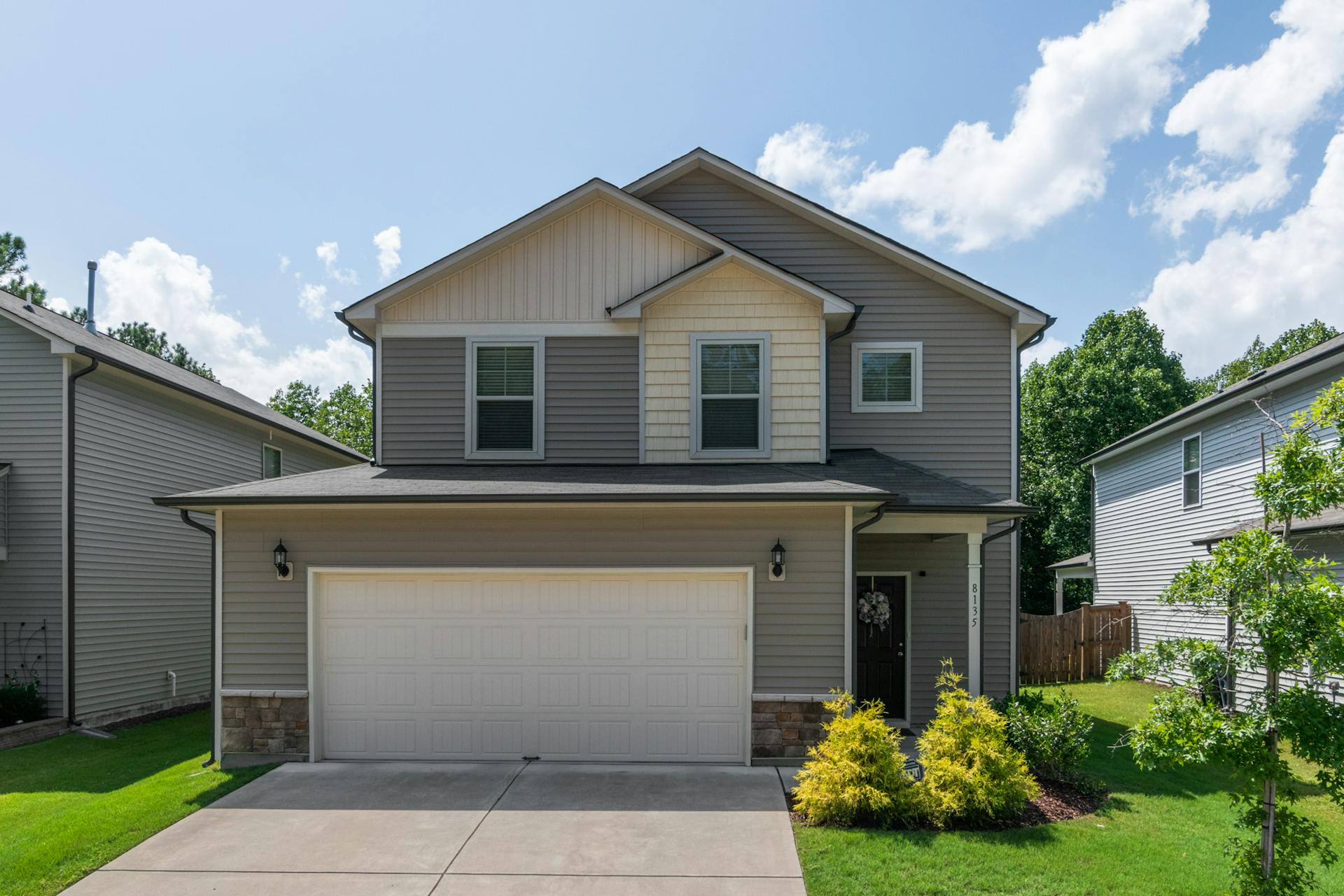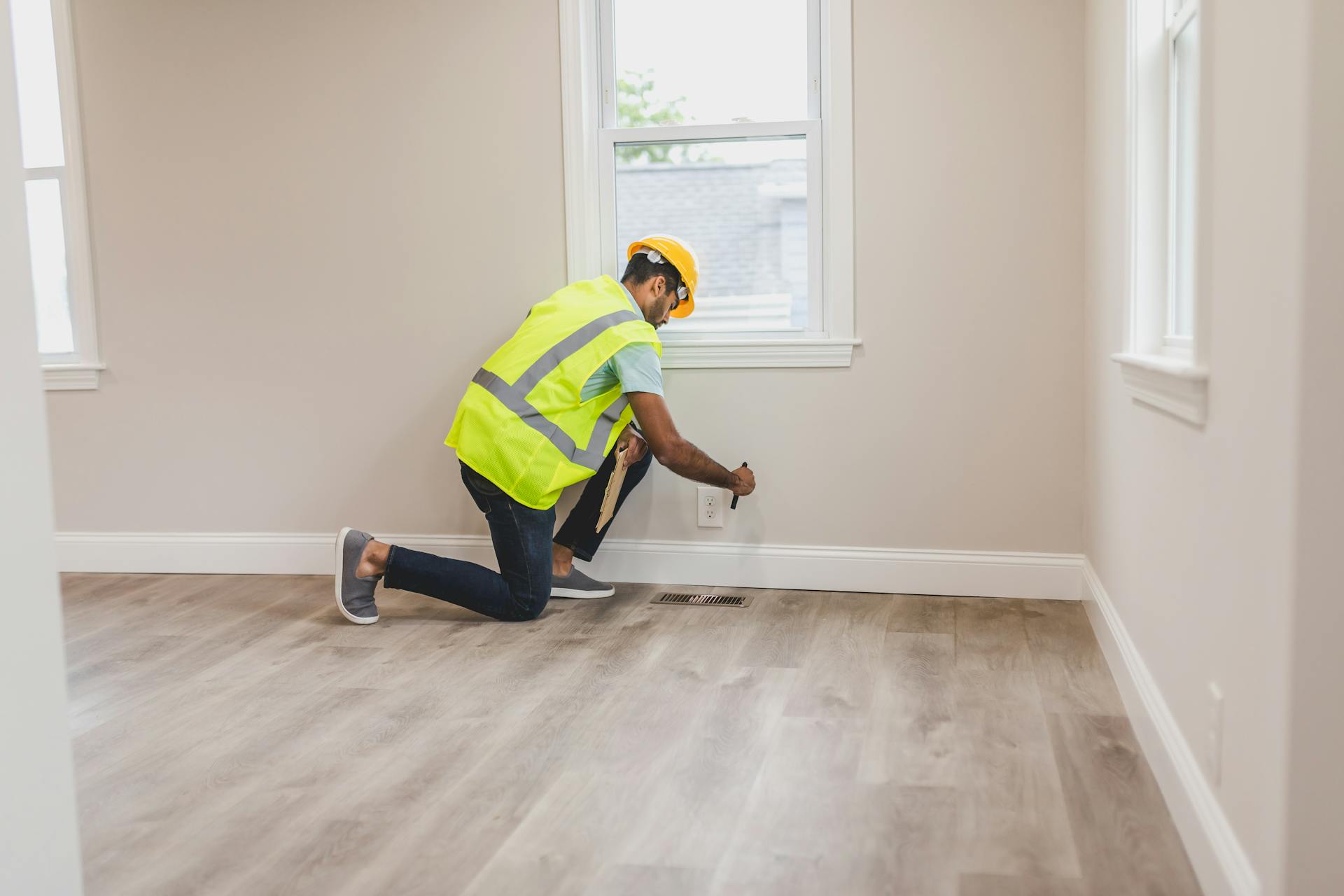
A reverse mortgage appraisal is a crucial step in determining the value of your home, which in turn affects the amount of money you can borrow. This is because a reverse mortgage is a loan that allows homeowners to borrow money using the equity in their home.
The appraisal is conducted by a licensed appraiser who will visit your home and assess its value based on factors such as its size, condition, and location. They will also consider the sales data of similar homes in your area to determine a fair market value.
The appraised value of your home will directly impact the amount of money you can borrow, so it's essential to understand the appraisal process. The appraiser's goal is to determine a value that is fair and reasonable, taking into account the unique characteristics of your home.
A typical appraisal process takes around 2-5 days, depending on the complexity of the appraisal and the availability of the appraiser.
Additional reading: Reverse Mortgage Appraisal Problems
What Is?
A reverse mortgage is a federally backed loan available to homeowners 62 years or older to borrow against their home's equity without monthly mortgage payments.
Homeowners can receive their funds as a lump sum payment, monthly payments, or a line of credit to draw from as needed.
To qualify for a reverse mortgage, the home must be the primary residence of the homeowners, and they must have equity built up in the home, with the home also being in good condition.
Homeowners are still responsible for paying property taxes, homeowners' insurance, and maintaining the home.
The amount of money received from a reverse mortgage depends on the age of the youngest borrower, interest rates, the FHA lending limit ($1,149,825 as of 2024), and the market value of the home.
An appraisal helps determine the total loan amount, which is crucial in determining how much money homeowners can borrow.
Check this out: Do You Make Payments on a Reverse Mortgage
Who Qualifies?
To qualify for a reverse mortgage, you must be at least 62 years old. This is a must-have requirement, and it's non-negotiable.
You must also occupy the property as your principal residence. This means the home you're taking out the reverse mortgage on must be your primary place of living.
To own the property, you must either have it paid off in full or have paid off a considerable portion of any debt on it. This is a crucial factor in the loan application process.
Adequate financial resources are also a must. You'll need to have enough money to keep up with the home's property taxes, insurance, and other fees. This will be verified by the mortgage lender as part of the application process.
Here are the specific requirements in a nutshell:
- Be at least 62 years old
- Occupy the property as your principal residence
- Own the property outright or have paid off a considerable portion of any debt on it
- Have adequate financial resources to cover property taxes, insurance, and other fees
The Process
The reverse mortgage appraisal process involves several steps to ensure the integrity and accuracy of the appraisal. The lender orders the appraisal from an appraisal management company (AMC), who then pays the appraiser.
The first step in the process is a home inspection, which includes a thorough examination of both the interior and exterior of the property. This may involve taking pictures and measurements to get an accurate assessment of the home's condition.
See what others are reading: No Appraisal Mortgage Loans
The appraiser also assesses the surrounding neighborhood and researches similar homes that have recently sold to determine the home's value. This helps to ensure that the appraisal is accurate and fair.
Here are the steps involved in the appraisal process:
- Order the Appraisal: The lender orders the appraisal from an AMC.
- Home Inspection: The appraiser inspects the home, including the interior and exterior.
- Assess the Area: The appraiser looks into the neighborhood and researches similar homes that have recently sold.
- Write up the appraisal: The appraiser puts together the appraisal, including the value of the property and any recommended repairs.
- FHA Approval: The appraisal is reviewed and approved by the FHA.
How it Works
The reverse mortgage appraisal process involves evaluating the home's age, location, square footage, and features, including the number of bathrooms and bedrooms.
The appraiser compares the home to similar homes in the neighborhood that have recently sold to determine its value.
The appraisal highlights any deficiencies and needed repairs, particularly health and safety concerns, such as electrical or structural issues.
The appraiser creates a report for the mortgage lender, who uses the evaluation when calculating the loan amount to the borrower.
The Federal Housing Administration (FHA) insures reverse mortgages issued by FHA-approved lenders, and these loans are formally known as home equity conversion mortgages (HECMs).
Private lenders also offer proprietary reverse mortgages, which are not government-insured and can have different qualification requirements and lending limits.
Some state and local agencies and nonprofit organizations offer single-purpose reverse mortgages, typically for low- and moderate-income homeowners.
See what others are reading: Fha Reverse Mortgage
The Process

The appraisal process for a reverse mortgage is a crucial step in determining how large of a loan you could be eligible for. It's ordered by the lender from an appraisal management company (AMC), who pays the appraiser and ensures the integrity of the process.
The first step is a home inspection, where the appraiser checks both the interior and exterior of the property, taking pictures and measurements as needed. This helps the appraiser get a clear understanding of the home's condition.
The appraiser will also assess the neighborhood and surrounding area, researching similar homes that have recently sold to determine the property's value. This is a critical step in determining the loan amount.
The appraiser will then write up the appraisal, including the value of the property and any recommended repairs needed to pass HUD's requirements. This report is used by the mortgage lender to calculate the loan amount.
Here's an overview of the appraisal process:
- Order the appraisal
- Home inspection
- Assess the area
- Write up the appraisal
- FHA approval
The FHA reviews and approves the appraisal, and if necessary, may order a second appraisal if they don't think it's accurate. This ensures that the appraisal is thorough and reliable.
Cost and Fees
A reverse mortgage appraisal can cost around $625, which includes the fee for the AMC (Appraisal Management Company) and the fee for the appraiser. This cost can vary depending on the complexity of the property.
The appraisal fee itself can range from $450 to $550, depending on where you live. This fee is paid to the AMC, which coordinates the appointment with the appraiser.
It can take 15 to 30 days to complete the appraisal process, including scheduling, the appointment, research, and the final valuation. This timeframe can vary depending on the appraiser's schedule and the complexity of the property.
You may have the opportunity to appeal an appraisal if you feel the valuation is way off base. However, this only happens in a very small percentage of cases, resulting in a new valuation.
In addition to the appraisal fee, you can expect to pay an origination fee to the lender, not to exceed $6,000 for a government-insured mortgage. This fee can vary from lender to lender, making comparison shopping worthwhile.
Here are some common fees associated with a reverse mortgage:
Property Inspection and Value
A reverse mortgage appraisal is a thorough process that involves evaluating the property inside and out, just like a typical home appraisal. The appraiser will take a close look at the home's exterior, interior, and surrounding neighborhood.
They'll be on the lookout for any structural and safety issues, such as plumbing and electrical problems. The appraiser may also make measurements, take photographs, and review relevant legal documents.
If the appraiser finds that repairs are needed to bring the home up to HUD's minimum property standards, the homeowner may need to complete them before receiving the loan.
Property Inspection
The property inspection is a crucial step in the appraisal process for reverse mortgages. The appraiser will evaluate the home's exterior, interior, and surrounding neighborhood.
They'll be on the lookout for any structural and safety issues, such as plumbing and electrical problems. This is a thorough examination that can take some time.

The appraiser may make measurements, take photographs, and review relevant legal documents. This information will be used to determine the value of the property.
Note that the appraiser will also make note of any repairs or other work necessary to bring the home up to HUD's minimum property standards. If substantial repairs are required, the homeowner may have to complete them before receiving the loan.
Related reading: Who Pays the Property Taxes on a Reverse Mortgage
Good Shelf Life
A reverse mortgage appraisal is valid for 180 days from the completion date. This means you have a good amount of time to decide on your next steps after the appraisal is complete.
In the past, appraisals were only good for 120 days, but that changed in 2022. HUD extended the validity period to 180 days, making the process a bit more straightforward.
This change removed the need for a 30-day extension, which was a hassle to manage. Now, you can focus on the next steps in your reverse mortgage process without worrying about a tight deadline.
The 180-day validity period gives you plenty of time to review the appraisal and make any necessary adjustments. It's a bit more breathing room, which is always a good thing.
Related reading: Is Reverse Mortgage Legit
Timeline and Disagreements
A reverse mortgage appraisal can be a lengthy process, but it's essential to understand the timeline involved. The appraisal process typically takes 3-5 days, but it can take up to 30 days in some cases.
If you disagree with the appraisal, you can challenge it by filing a request with the appraiser, along with reasons why you believe the appraisal should be changed. This is a crucial step in ensuring the appraisal accurately reflects the value of your home.
Finalization Timeline
A reverse mortgage can take up to 45 days to complete from start to finish.
The appraisal process can add an extra 15 to 30 days to the overall timeline, so it's essential to plan accordingly.
Your lender will provide a more accurate timeline, taking into account their specific processes and requirements.
The exact timeline can vary depending on your lender and other factors, so it's best to ask your lender for a more detailed estimate.
What If I Disagree?

If you disagree with the appraisal, you can challenge it. This is done by filing a request with the appraiser, along with reasons why you believe the appraisal should be changed.
You can challenge an appraisal if you believe it's inaccurate. This is a common occurrence, and it's not uncommon for homeowners to disagree with the initial appraisal.
You can file a request with the appraiser, providing specific reasons why you think the appraisal is incorrect. This shows that you've taken the time to review the appraisal and understand the issues.
A request to challenge an appraisal is typically made in writing, and it's essential to be clear and concise about the reasons for your disagreement.
A different take: Why Would Someone Use a Reverse Mortgage
Preparation and Expectations
Preparing for a reverse mortgage appraisal can be a bit overwhelming, but knowing what to expect can make the process much smoother. You can start by doing your homework and checking websites like Zillow or Redfin to get an estimated market value of your home.

It's a good idea to take care of any obvious repairs before the appraisal, such as making sure working smoke detectors are installed in all rooms, the attic is accessible, and the stove and toilets are in working order. This can help speed up the process or prevent any issues that may slow it down.
The appraisal process typically involves three steps: inspection, research, and appraisal. During the inspection, the appraiser will walk through your home with you and take photos to research your home's value. They will focus on any areas that may be in need of repair and specific features of your home that could contribute to or take away from its value.
The inspection process can be a bit invasive, but it's essential to ensure that your home is accessible for the appraiser. This includes exterior spaces, basements, and attics. If you live in California, you'll need to ensure that your home meets specific regulations, such as having smoke detectors in all bedrooms and earthquake straps on water heaters.
Here's a breakdown of the typical steps involved in the appraisal process:
By understanding what to expect from the appraisal process, you can prepare your home and yourself for a smooth and successful experience.
Reporting

The appraiser should provide copies of their appraisal to the mortgage lender or financial institution, who will forward a copy to you. This is a standard procedure.
The Equal Credit Opportunity Act requires creditors to automatically send a free copy of home appraisals and all other written valuations on the property after completion, regardless of whether credit is extended, denied, incomplete, or withdrawn.
It can take 15 to 30 days to complete the appraisal process, including scheduling, the appointment, the research, and the final valuation.
If you disagree with the appraisal, you can challenge it by filing a request for reconsideration of value with the appraiser, along with comparables that you believe more fairly represent the home's value.
The appraiser is required to review that information, but it's up to them whether to make any changes as a result.
Discrimination during the appraisal process is prohibited under the Fair Housing Act and Equal Credit Opportunity Act.
If you believe you have experienced discrimination, call the Appraisal Complaint National Hotline at 1-(877) 739-0096.
A unique perspective: Hecm Line of Credit
Frequently Asked Questions
What is the 60% rule in reverse mortgage?
The 60% rule in reverse mortgage limits HECM borrowers to taking the greater of 60% of their total available equity or 110% of their mandatory obligations in the first payout. This rule helps ensure borrowers don't over-borrow against their home's value.
Sources
Featured Images: pexels.com


